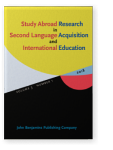Vol. 3:1 (2018) ► pp.84–116
Vol. 3:1 (2018) ► pp.84–116
Leave-taking in Indonesian during short-term study abroad
This study uses multiple sources of data to examine the learning of leave-taking in Indonesian by twelve students from Australia during a sojourn of either four or seven weeks. The learners departed with very little knowledge of leave-taking routines. They rapidly learned the forms of certain routines, and used them often. However they did not learn suitable contexts for them, and also failed to learn a number of other common routines. Under influence of English, they relied excessively on statements of obligation for taking leave but also adopted one useful discourse marker. The study confirms that pragmatic routines are a site of rapid learning during study abroad, while suggesting some very common routines are hard to learn by naturalistic exposure. It confirms study abroad learners are often slow to learn to adjust forms to social context, and shows the powerful influence of L1 transfer on their pragmatic development.
Article outline
- 1.Introduction
- 2.Background
- 2.1Pragmatic development during study abroad
- 2.2Leave-taking
- 2.3Learning leave-taking during study abroad
- 2.4Leave-taking in Indonesian
- 3.Method
- 3.1Participants
- 3.2Elicitation of data
- 3.3Procedure
- 4.Findings
- 4.1Use of routines in pre-test vs. post-test: Overview
- 4.2Learning of sampai nanti and sampai jumpa
- 4.3Learning of additional routines
- 4.4Other features of their leave-taking
- 4.4.1Statements of obligation
- 4.4.2Thanking
- 4.4.3Discourse marker: Oke ‘okay’
- 4.4.4Learning of appropriate contexts for pragmalinguistic forms
- 4.4.5Dealing with perceived problems in taking leave
- 5.Discussion
- 5.1Participants’ learning of the forms of routines: Key factors
- 5.1.1Knowledge before departure: The role of formal instruction
- 5.1.2Successful learning of certain forms: The role of interaction and noticing
- 5.1.3Narrow range of routines: The role of low salience and non-target-like input
- 5.2Uniqueness of learning paths: The role of multiple factors
- 5.3Slow learning of contexts: The role of limited exposure and non-target-like input
- 5.4Reliance on obligation statements: The role of L1 transfer
- 5.5Indiscriminate thanking: The role of L1 transfer and learner identities
- 5.6Learning of the discourse marker oke: The role of L1 transfer
- 5.1Participants’ learning of the forms of routines: Key factors
- 6.Conclusions
- Notes
-
References
